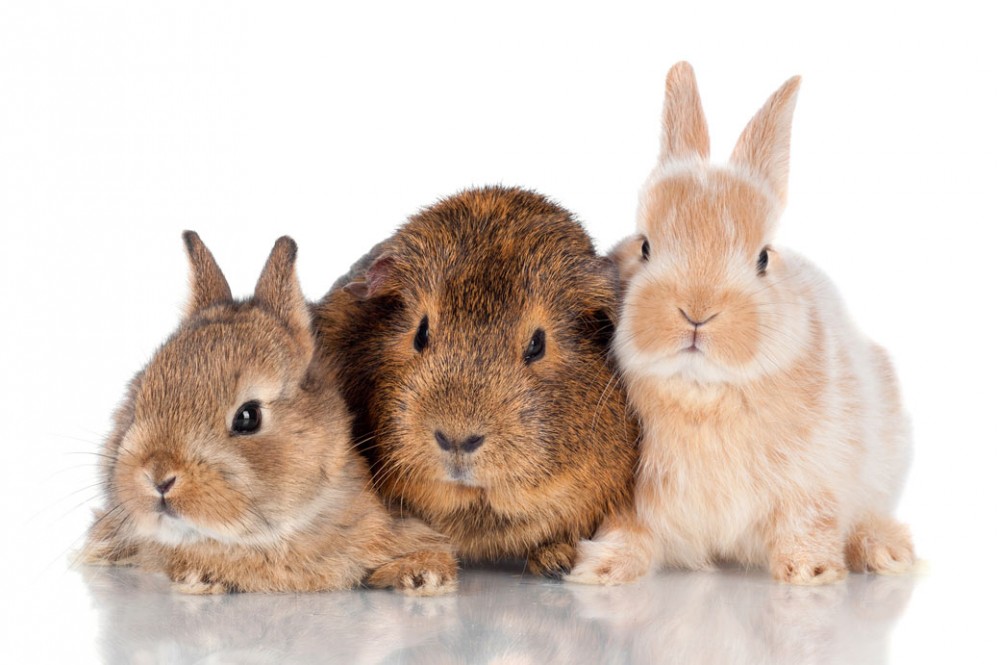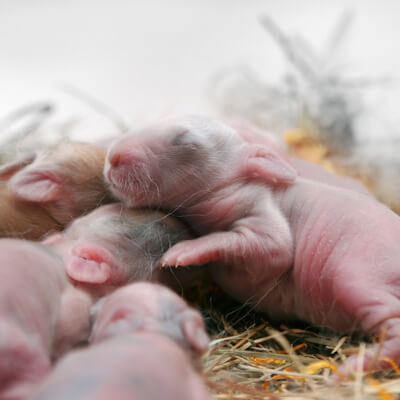Neutering of rabbits
Rabbits are very social animals and should therefore be kept in a group. However, if they are not neutered, there can be a whole host of problems between them.
Individually raised rabbits, especially males, can be very aggressive towards the breeder or other rabbits. Females are often aggressive during heat. Keep in mind that they come into heat every 26-28 days, so this is a fairly regular affair. Often in heat, they pluck their hair and build a nest. If you have a mixed couple, have both individuals neutered so that they can have a nice and harmonious life together. If you breed a neutered female, then the unneutered male will try to cover her. This can stress the female and lead to mutual fights. Conversely, if you castrate only the male and do not castrate the female, she may suffer from a false pregnancy. He will probably be aggressive as well. At the same time, you risk her premature death due to uterine cancer. Even among castrated individuals there may be signs of sexual behavior. But these are rather manifestations of dominance than reproductive activity and it is a completely natural behavior, especially in females.

Why neuter rabbits?
One of the main reasons to neuter rabbits is to prevent unwanted pregnancies. It is not for nothing that the statement is used: " They multiply like rabbits". Rabbits are very prolific and breed really fast. If they are kept in a group, it is very common for them to cover the female with the male a few hours after giving birth. Immediately after castration, the female is infertile, but males are able to cover the female for 6-8 weeks after castration. This is because the mature sperm could leave the testes and enter the vas deferens, where it can survive for a surprisingly long time. Therefore, it is better to keep a freshly neutered male in isolation from unneutered females for at least 6-8 weeks.
Another reason for neutering rabbits is their safe pairing or group formation. Rabbits can be very lonely if kept alone. We therefore recommend keeping two rabbits together in a pair or more rabbits in a group. Hormonal activity in non-castrated rabbits fluctuates greatly and fights between them are therefore very frequent. It is also for this reason that we recommend castrating rabbits.
Prevention of unwanted territory marking by males or false pregnancy in females are other reasons for castration of rabbits.
Finally, castration of rabbits also serves as a prevention of health problems - for example, uterine cancer, testicular tumors.
Benefits of neutering male rabbits
- Prevention of unwanted reproduction
- Unneutered males mark their territory with urine, similar to cats.
- Tumors of the testicles and prostate occur in uncastrated males. Although the risk is low, it is completely preventable by castration.
- Neutering allows easier socialization of rabbits.
- Unneutered males can be aggressive. After castration, there is a rapid decrease in the level of testosterone, the male sex hormone, and this can significantly reduce or even completely limit the rabbit's aggressive behavior.
- An unneutered male cannot be safely kept with any other rabbit, male or female.
Benefits of neutering female rabbits
- Unneutered females have a relatively high risk of serious disease - uterine cancer and pyometra (inflammation of the uterus). Both of these conditions can result in the death of the animal.
- Some unneutered females are aggressive and territorial. Many have repeated false pregnancies. They can be aggressive towards the breeder or towards other rabbits, especially in spring and summer.
- Cohabitation of two unneutered females together can further escalate their aggressive behavior.
- Unneutered females are capable of conceiving from 4-6 months of age. Females can recoat just a few hours after giving birth, so if a male is nearby, further population growth can easily occur.
When to neuter a male rabbit
Male rabbits can be neutered from 10-12 weeks of age, or after the testes descend into the scrotum. In such a case, it can be placed directly with other domesticated rabbits without the risk of unintended covering of unneutered females. If you have him neutered later, the males are not sterile immediately after the procedure, as already mentioned in the text above. Castration of males is a relatively simple performance.
When to neuter a female rabbit
Females are neutered from the 4th to the 5th month. This is a more demanding surgical procedure. If you keep a female with an unneutered male, you can put them together right away, but only if the male does not attack the neutered female (he could injure her postoperative wound). Otherwise, keep them in separate areas for a few days. This allows them to see and sniff each other, for example through wire mesh.
We always perform the neutering of rabbits in the Vethope veterinary clinic under a gentle general inhalation anesthesia SAFETY+. Healthy rabbits normally tolerate it well and begin to eat immediately after waking up. The benefit of neutering therefore far outweighs the risk and possible complications associated with anesthesia and surgery.

Care of the rabbit before neutering
Do not make any changes to your diet a week before the planned surgery. The rabbit is unable to vomit, so we do not require fasting before the procedure, as is the case with dogs and cats. They must have good quality food and access to water at all times before and after surgery.

Postoperative care of rabbits
After neutering, we recommend keeping the rabbit in a cage, usually for 2 days for males, 5-6 days for females. Males generally cope well with the operation, but females may be more restless on the day of the procedure. The most important thing is that they start eating as soon as possible after the operation. Offer them freshly picked grass or herbs and good quality hay. If the rabbit does not accept food by the next day, be sure to contact the veterinarian. Also, monitor the rabbit's stool for several days after the operation - it must poop regularly. If a few hours after returning home the rabbit produces little or no fur, contact your veterinarian again.
Disclaimer: This article is only informative and does not replace professional consultation or examination of the animal by a veterinarian. If you have any doubts about health of your pet, contact yours veterinarian immediately.
13.09.2022


